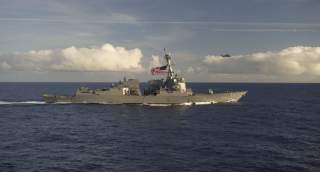Scarborough Shoal: A Red Line for the Philippine-U.S. Military Alliance?
China might push too far if it turns Scarborough Shoal into its next fake island.
As U.S. defense secretary Ashton Carter visited the Philippines at the end of the annual Balikatan military exercises between the Philippines and the United States, anxiety was quietly building over the possibility that China would create a new artificial island on Scarborough Shoal, very close to Manila. Such an undertaking would come as the Philippines experiences a transition in political leadership via presidential elections in May. Despite hopes in Manila, Carter did not offer an official assurance of U.S. assistance in preventing Scarborough from being permanently taken over by China, though his visit, which included a trip with Philippine defense secretary Voltaire Gazmin to a U.S. aircraft carrier transiting the South China Sea, was intended to signal Washington’s commitment to the alliance.
The general U.S. policy of neutrality on questions of sovereignty over South China Sea land features was originally established in the 1930s in response to Japan’s pre-war annexation of the Paracel and Spratly islands. But Scarborough Shoal was treated separately and very differently from those island groups up until the 1990s. Unlike the Paracels and Spratlys, Scarborough was among the territories transferred by the United States to the Philippines upon the latter’s independence, though the shoal was not widely known. The 1900 Treaty of Washington between Spain and the United States clarified that any and all territories administered by Spain as part of the Philippine Islands, even if they were located outside the original 1898 Treaty of Paris lines circumscribing the Philippine archipelago, were ceded to Washington. The United States took over Spain’s administration of Scarborough for purposes of safety of navigation, fishing, research, search, rescue, and salvage activities. In 1938, upon official inquiries, the U.S. Department of State recognized that the United States acquired title to the shoal from Spain on the basis of the 1900 treaty, and subsequently allowed Scarborough’s transfer to the Philippines with concurrence of the Secretary of the Navy and the Secretary of Commerce. (See primary documents)
The Philippines took over the shoal’s administration in 1946 upon its independence. After the Philippine Navy twice destroyed smugglers’ bases on the shoal in 1963, a 20-nautical-mile Naval Operating Area was established around it, turning Scarborough into a gunnery range and extension of U.S. military bases in the Philippines. The security perimeter kept out any further incursions by private parties, but seasonal fishing and occasional surveys and scientific research were allowed. The area was regularly used by Philippine and U.S. military forces openly and publicly until the U.S. bases closed in 1991. Only afterward did China actually take concrete action to assert its long-dormant paper claim to the shoal, beginning with the issuance of amateur-radio licenses to hobbyists in 1994. These later intensified into the assertion of traditional fishing rights into the early 2000s that eventually grew into a claim based on historic rights and title, and finally culminated in China’s coercive exclusion of all Philippine fishing and law enforcement activities from the shoal since 2012.
At first blush, Scarborough presents a possible red line for the Philippine-U.S. military alliance. As a former U.S. territory transferred to the Philippines, it may be covered by the Mutual Defense Treaty that obligates the United States to help defend not only the Philippine metropolitan territory, but also “island territories under its jurisdiction.” Should the Philippines decide to deploy its ships to prevent the approach of vessels intended for island-building, Manila would expect the United States to make good on assurances that it will help defend Philippine “public ships and aircraft,” (meaning not only military vessels) from armed attack in the Pacific, including the South China Sea, as required by the treaty. It could be argued that employment of the same kinds of tactics Chinese maritime law enforcement or militia vessels used against the Vietnamese in 2014 in their confrontation over the deployment of an oil rig in contested waters, which included the deliberate ramming and sinking of smaller, weaker vessels by larger though lightly armed Chinese ships, would still qualify as an armed attack. Ramming, after all, is an age-old tactic used in naval warfare.
The transformation of Scarborough into an artificial island-fortress similar to Mischief Reef would be the endgame in China’s rush to establish and consolidate administrative control over the South China Sea. Not only the Philippines, but other littoral states, the United States, Japan, and allied powers have an interest in preventing this, given how China has employed nominally-civilian assets in “grey zone” activities that push the envelope of tolerable behavior at sea. If the South China Sea were “captured” through the completion of what some view as a “strategic triangle” for monitoring and controlling maritime activities, including shipping and air traffic, these countries should be expected to do whatever was necessary to neutralize that strategic advantage. Despite their reservations over great power competition, Southeast Asian states will not quietly surrender sovereign rights guaranteed by international law. Against overwhelming power, the only logical recourse is to gravitate closer together, and join with external powers. Thus, by undertaking island-building on Scarborough, China could well create the final catalyst for its own strategic containment.
This piece first appeared at CSIS: AMTI here.
Image: U.S. Navy Flickr.

